4-H Robotics: Working to Make a STEM Career Down the Line Automatic
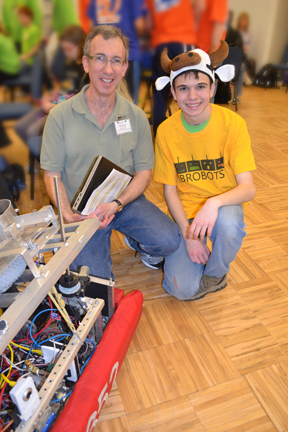
4-H Robotics Educator Bob Smith and a participant in the 2013 Robotics Competition pose by a robot.
May 13, 2013
"My whole goal in this is to get more kids in STEM," 4-H Educator Bob Smith unashamedly acknowledges. In charge of 4-H Robotics for the state of Illinois, Smith provides training, expertise, and curricula for county-level 4-H club leaders and also oversees 4-H's state-wide robotics competition.
4H's Robotics program is part of an initiative begun in 2005 to emphasize STEM education. J.C. Penney gave the youth development organization an $8,000 seed grant to start six teams. Now there are at least 60 or 70 robotics teams in 4-H. And at least 41 of them (up from 25 last year) showed up on campus on April 20th for the 5th Annual 4-H Statewide Robotics Competition held at the ARC.
For "Stormbot," the theme of this year's competition, teams were to use a LEGO MINDSTORMS kit to build a robot and write a program enabling their robot to automatically navigate a 4 by 8 foot playing field performing specific actions.
This was the Stormbot scenario: a storm or natural disaster had blown through a town, leaving a structure still standing. However, another storm was approaching. So the robot was to build a barricade around the structure (the more sides on the barricade, the more points teams would get), and could also move and stack up debris to get additional points. Since two age-groups competed, (Juniors [9–14-year-olds] and Seniors [14–18-year-olds]), the scenario provided either easier or more challenging programming options, depending on the age of participants.
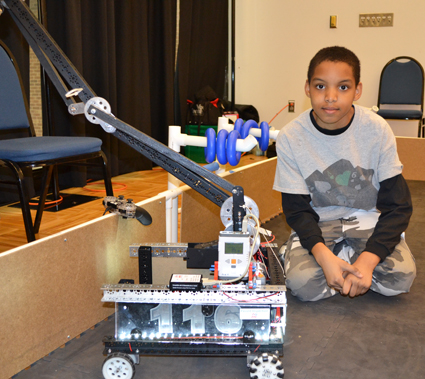
Participant from the Chicago area displays the large robot his team built.
Many 4-H Robotics teams also participate in competitions sponsored by FIRST (For Inspiration and Recognition of Science and Technology), a national organization that provides four robotics competitions for children of all ages. The difference in the competitions? The size, cost, and complexity of the robots; ages of participants; and the size of teams. FIRST competitions include:
- Junior FIRST LEGO League (Jr.FLL), for students grades K–3 (ages 6–9).
- FIRST LEGO League (FLL), for younger students (grades 4–8, ages 9–14). Teams use LEGO MINDSTORMS kits; 20 of the 350 teams in the state were 4-H teams.
- FIRST Tech Challenge (FTC), for kids in grades 7–12. Fairly inexpensive, the kits cost around $2,000; the robots are smaller, and there are around 10 kids per team. Four of 70 or 80 teams in the state were 4-H teams.
- FIRST Robotics Competition (FRC). The most expensive and the most difficult, it also has the largest robots. Because it can cost up to $15,000, the kids have to do fundraising. It's also the most like real engineering, where the kids do the design themselves and even fabricating parts out of metal. Also, these teams are larger; it's common to have 20 kids on a team. Of 70 FRC teams in the state, 10 were from 4-H.
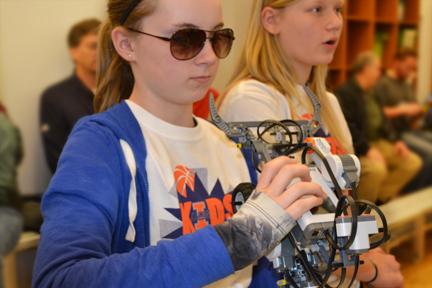 Two contestants competing in the 4-H Robotics Competition.
Two contestants competing in the 4-H Robotics Competition.Smith reports that another 30–40 4-H clubs do robotics, but don't compete. Instead, they might show their robots at their county fair. Says Smith, "They're building robots, but for whatever the reason, don't want to go compete. My next goal after the competition is to visit these groups and find out what else I can do to help them. Because whether they're competing or not, I want them to continue with robotics and maybe end up in a STEM career."
However, before Smith can provide support to the 4-H robotics teams, he has to actually locate them. He must also determine which of all the teams that participate in FIRST are actually 4-H teams. This is challenging because many teams don't necessarily include "4-H" in the name of their team.
The main support he provides is training—helping 4-H club leaders with the technical side of building and programming MINDSTORMS robots. His is also developing training curricula. In one curriculum he's developed, "Junk Drawer Robotics," teams would build robots out of stuff from the junk drawer, for example, a marshmallow launcher. One of his goals is to encourage youngsters who build something like that to see if they can modify it and put it on their actual robot.
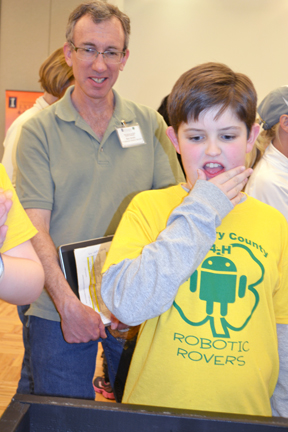
Bob Smith (left) watches a member of the Robotic Rovers team compete in the 2013 Robotics Competition.
While Smith doesn't have many opportunities to actually train kids, he is working on a model where the older team members will hold workshops to train younger teams in their geographic area.
So how did Smith, a mechanical engineer by trade, get involved with robotics? It all started when he helped coach some local FIRST Lego League teams of 4th and 5th graders several years ago. A few years later, he took over running the FIRST Lego League tournament in Champaign. Now, he's in charge of the 4-H robotics program for the whole state.
So, do kids who participate in robotics end up choosing STEM careers? Smith intends to find out. He has plans to track kids in 4-H robotics to determine how many high schoolers end up going into engineering or STEM fields.
Smith believes the skills kids acquire learning how to build robots are similar to those that would be useful in a STEM job, such as engineering. "Robots are what catches people's attention. But the design that goes into a robot can be used for making cars, making tractors, factories, anything." Smith continues: "My hope is that if there are kids who didn't realize that careers like this were available to them, that they would be able to see that, 'Oh, this is really cool. This is something that I would like to do!' and then have them go on and go into STEM careers."
Story and photos by Elizabeth Innes, Communications Specialist, I-STEM Education Initiative
More: 4-H, FIRST, K-12 Outreach, STEM Pipeline, 2013
For more information about 4-H STEM programming, see this additional I-STEM web article:
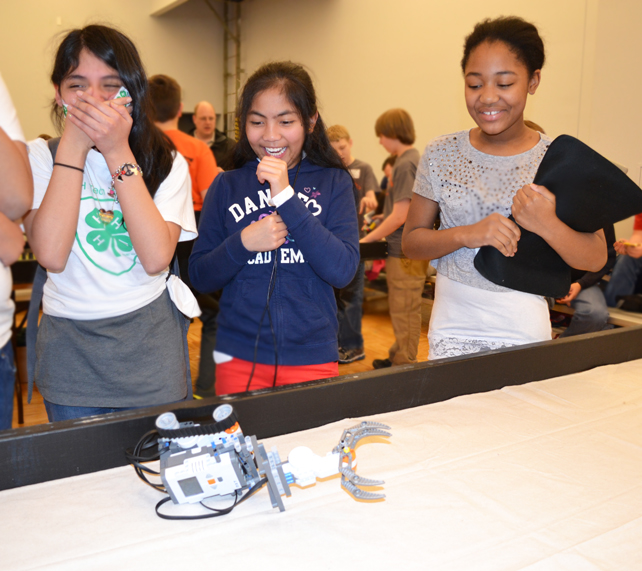
Despite their robot's failing to correctly perform its programming, the members of a robotics team enjoy its antics during the competion.













.jpg)
















